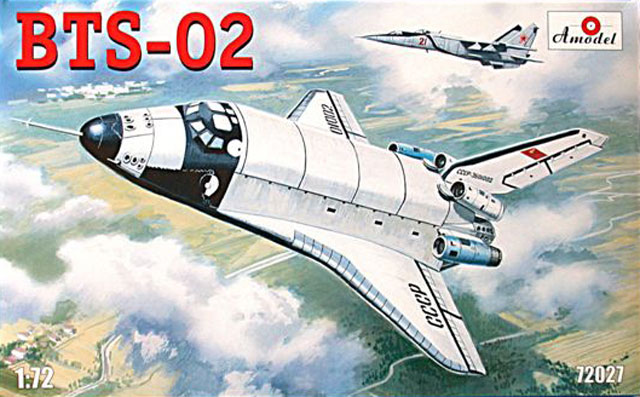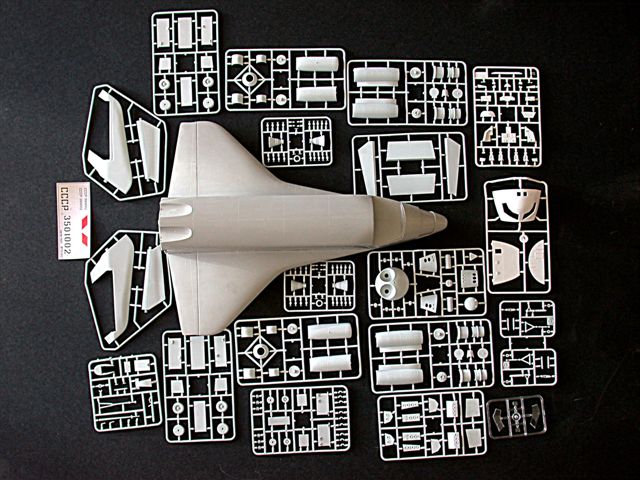|
“Buran” Space Shuttle Trainer BTS-02

Amodel, 1/72 scale
S
u m m a r y
|
| Catalogue Number: |
Amodel Kit No. 72-027 - “Buran” Space Shuttle Trainer BTS-02 |
| Scale: |
1/72 |
| Contents and Media: |
Hand-laid epoxy glass over gelcoat for main parts, plus short-run injection moulded plastic |
| Price: |
USD $175 + postage. Obtained from Linden Hill Imports |
| Review Type: |
FirstLook |
| Advantages: |
Finely
recessed surface features; appropriate use of multi-media (large epoxy parts are rigid despite their size) |
| Disadvantages: |
Limited run nature of the kit means
that modelling skills will be required |
| Conclusion: |
Expensive to buy and challenging to build, but another great subject for the Evil Empire niche of the hobby |
Reviewed by "Bondo" Phil Brandt

HyperScale is proudly supported by Squadron.com
The Soviet space shuttle program started earlier than that of the U.S., but the Buran shuttle didn’t fly until late 1988, and any further flights were then suspended after that one successful unmanned sortie of two orbits. Program cancellation came in 1993. As in the case of the breakup of Soviet Union’s military assets, the main cause was lack of funding.
Although the Buran orbiters appear identical and measure out very closely to NASA’s shuttles, the Energia-Buran concept was designed to far surpass the performance and cost effectiveness of the U.S. program. For instance, the gigantic Energia boosters were all of the generally acknowledged less dangerous liquid fuel design, not liquid/solid as in the U.S.rocket grouping.
The heavy lift capability (with maximum strap-on booster configuration) of the Energia-Burans surpassed that of NASA’s shuttles by at least a factor of five; the Buran didn’t have booster rockets of its own (as opposed to U.S. shuttles), and thus had a larger cargo bay. In addition, the Energia core booster was designed to be reusable, as compared to the huge NASA Shuttle central tank which is sacrificed on each mission. All strap-on Energia boosters were also designed for soft landings and reuse for ten missions.
Some eight Buran Space Shuttle test articles were scheduled to be built, but only one was for actual flight training. The subject of this latest Amodel kit, BTS-02, achieved some eight hours of flying time starting in 1984, and, with it’s four huge jet engines, was able to take off on its own, as opposed to the Space Shuttle Enterprise training article which had to be air-launched from a modified Boeing 747 and then glide in to a landing.
The original Buran that completed two orbits in1988 was destroyed (along with its Energia booster) when the roof of the hangar in which it was displayed ( in Kazakhstan) caved in under fierce winds. After a display trip that included stops in Australia and Bahrain, the BTS-02 training article went back to Russia and then, finally, to an aerospace museum in Germany.
As is Amodel’s custom when fabricating its “Amonster” series of large Soviet subjects, main components, in this case the entire airframe, is pre-fabricated of hand-laid polyester cloth impregnated with epoxy glass resin.

Other than adding various injected components such as the flight deck, jet engines, control surfaces and landing gear, the hard work is already done.
Molding
The pre-assembled airframe surface is relatively defect free, and engraving is petite and quite acceptable. Injected parts (many, see parts pix) are as usual cast in relatively soft plastic with, sometimes, too large spigots attached to small parts. But, hey, that’s how it’s always been with limited production Amodel kits; nobody said (modeling) life would be fair!
Details
The separate flight deck assembly is reasonably detailed, even though the windscreen area is small. Instruments are represented simply by small holes. Seats do not have molded-in or separate PE harnesses.
Jet engines have two-piece casings and separate compressor and turbine faces, and inlet block-off panels can be positioned open or closed. Many small actuators on the afterburner cans have to be cleaned up and laboriously added, but they’ll add welcome busy-ness to otherwise plain assemblies.
Landing gear struts are well-detailed, with more individual pieces than are usually found in kits made in the West. Gear wells are built-up, with little detail on the interior surfaces, not that there’s that much in the real thing.
Fit
As with all A model kits, precise fit is, how shall I put it, not exactly Tamiyagawa-like, but then these kits are not targeted at “shake-n-bake warriors”.
Clear Parts
Minimal, but well done; injected, not vac.
Decals
Again minimal, but that’s the way high-heat shuttles/orbiters are done. Decals seem thin, but color and registration are good.
Instructions
No-text, with excellent exploded parts diagrams.
Another welcome eclectic addition to Amodel’s lineup of Soviet/Russian subjects.
Keep ‘em coming!
Reference
http://www.k26.com/buran/Info/energia_-_buran.html
A very informative and colorful website.
Sample purchased by reviewer
Review Text Copyright © 2009 by "Bondo" Phil Brandt
Page Created 9 January, 2009
Last updated
9 January, 2009
Back to HyperScale Main Page
Back to Reviews Page
|
Home
| What's New |
Features |
Gallery |
Reviews |
Reference |
Forum |
Search